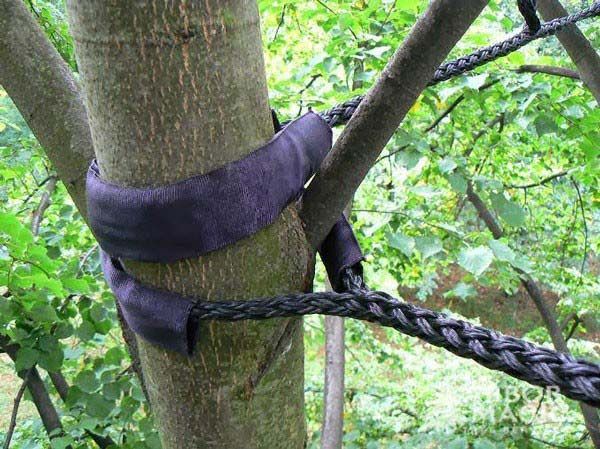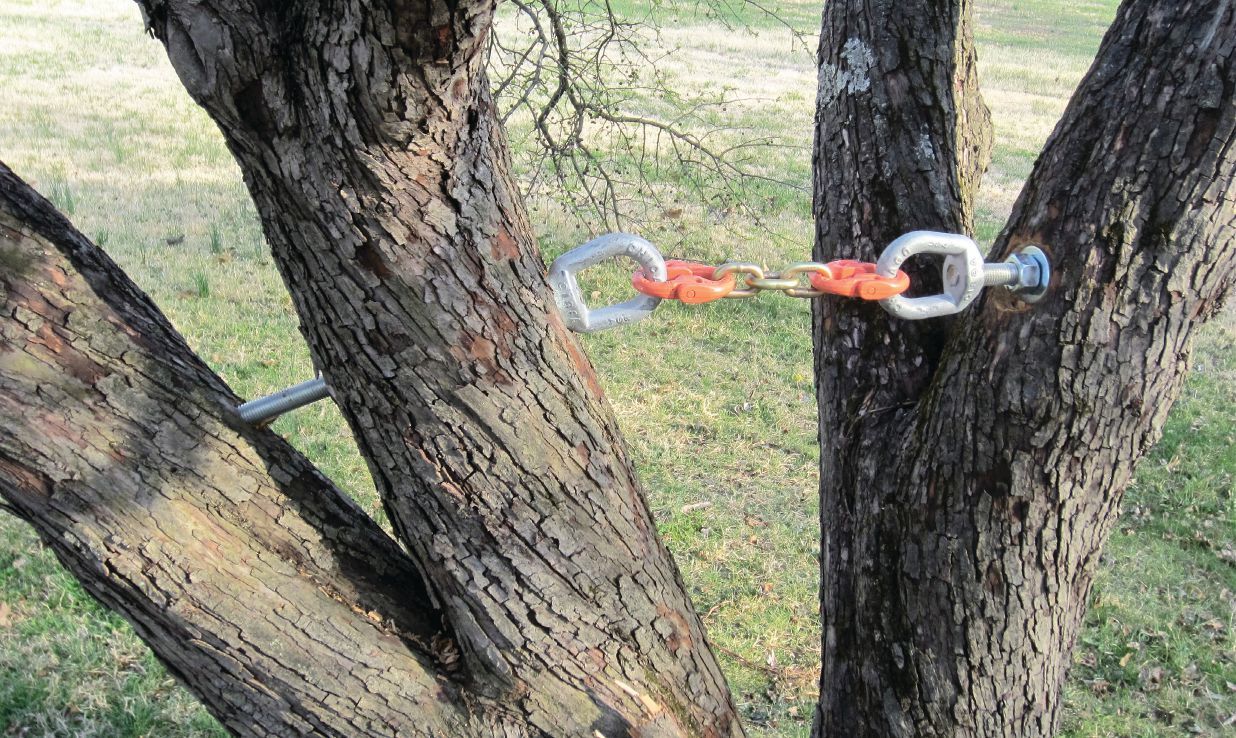Cabling & Bracing Victoria
Cabling and bracing are ways to hold your tree together so it doesn't drop branches or split apart.
Tree Cabling
When structural issues are identified, we may recommend installing a high-strength tensile steel cable in the upper crown of the tree. Cabling prevents branches from moving around as much - as a result, they're less likely to break during a storm. The cables are attached to the tree using bolts installed through the branches.
Tree Bracing
Bracing involves installing a long threaded rod through several branches or stems where they're weak and likely to split. The rod gives more support than a cable and limits the degree of twisting that can happen during violent weather.
Our arborists use approved materials and techniques that conform to all professional industry standards.

Get Instant Quote
Contact Us

Support For Healthier Stronger Trees
Over time, trees can develop structural defects or growth patterns that have a much higher probability of failing. The most common occurrence is a tree with multiple stems, which creates a cavity of included bark where the stems touch and appear to grow together. This is where they almost always split during a storm. Cables and bracing are supplemental structures that help reduce the risk of failure by limiting movement of suspect stems or branches during high winds in a storm or from snow loads. Cables are installed 2/3 of the way up into a trees canopy from the union so as to ensure the cable can apply a proper amount of leverage when holding stems in place. Bracing is when a threaded rod is installed through unions of weak branches or stems and in some cases we do both cabling and bracing on the same tree. In order to meet the acceptable risk threshold of our clients without removing a key tree we some times incorporate structural pruning and/or crown reduction pruning techniques that will help minimize the load on the suspect unions or stems along with cabling and bracing. At Victoria Tree Masters, we use a newer style cabling system where we drill a 3/8 inch hole straight through the tree where the steel cable passes, then we attach an aluminum collar that is tapered on the inside and locks the cable in place. This new does not rely on lag bolts that can rip out and thimble cable ends which can rust and break.
Our certified arborists will conduct a evaluation of your tree structure and make recommendations for installing cables and braces.
All bracing and cabling should have an annual inspection and will need to be replaced approximately every 10 years.
Signs That Your Tree Needs Support
Over time, many trees (especially those that haven't been properly pruned) develop structural weaknesses, such as:
- large, heavy, or multiple stems
- an imbalanced or lopsided tree canopy
- branches that move around too much, making them particularly vulnerable to breakage from strong winds
- tight crotches or upright branches that aren't well attached to the main tree trunk, making them more prone to splitting in half
These are all situations where structural support, such as cabling or bracing, can help protect your tree and save your property from damage.
Its important to remember cabling and bracing should only be installed by a certified arborist after a thorough inspection and evaluation of the tree. If you notice any signs of structural problems in your trees, give us a call. We'll inspect your trees to see if cabling or bracing can help. Often, a combination of proper pruning and cabling/bracing can help extend the life and improve the safety of important landscape trees.
When your tree has structural issues that can’t be resolved by pruning, but you don’t want to remove the tree, adding cables or bracing it with rods may be the answer. Not everyone is familiar with this arboricultural practice, however, so we’ve included some frequently asked questions, along with our answers, below.
My tree’s trunk has split apart. Can it be saved?
Depending on how significant the split is, the arborists at Independent Tree may be able to help trees with split trunks by the use of cabling. During this process, they attach strong cables between the limbs to limit movement, stabilize the tree, and prevent the split sections from separating entirely.
While many trees have a single trunk, others may develop two or more trunks, with those trunks branching off, forming a V. If the angle is less than 45 degrees, the structure of the tree is considered weak, and cabling may be necessary to prevent it from splitting.
Our tree has a long, heavy branch that is growing over a pedestrian area. How can we prevent possible future injury to passersby?
While you may think that removing the large branch is the only option, this may be a situation where cabling or bracing may help. These methods can prevent a large branch or even an entire tree limb from falling.
Contact us to schedule a consultation to see if tree cabling or bracing would help your tree.
Why is stump removal necessary?
Stumps in your yard are unattractive, reduce your home’s curb appeal, and sometimes occupy parts of your landscape you could otherwise use and enjoy. Worse still, stumps are dangerous because they – and their root systems — are a tripping hazard, particularly at night.
When a tree has been cut down, and a stump remains, that stump becomes a welcoming haven for invasive organisms that infiltrate the stump and lead to its further decay. Stumps host pests, snakes, and vermin. Once these species invade and multiply, they can prove quite expensive to remove. Timely stump grinding prevents these pests from inhabiting your yard.
Does cabling hurt a tree?
Not if done correctly. If cabling is done incorrectly, however, it can damage or even kill a tree. This is why it is important to hire tree care professionals, such as those at Independent Tree, to cable your trees.
Cabling can lead to girdling if done incorrectly, where a tree’s growth is impeded by the cables. Improperly anchored cables can come loose (sometimes damaging nearby structures) or break the branch to which they were attached. Knowing where to correctly place cables while preventing girdling over time is one of the benefits of hiring a professional for this task.
Can I add cabling to my tree myself?
We don’t recommend it. Even for smaller trees, the area that usually needs to be cabled is often far up in the canopy of a tree, meaning that at least a ladder is necessary to reach the area. Once you do any work on a tree that is not done from ground level, the chances of injury increase.
Skill and experience are needed to know how and where to properly add cabling and/or bracing to a tree. It also requires specialized equipment and cables that aren’t available in local hardware stores. Many DIY attempts lead to more structural damage, injury, or eventual girdling of the tree.
How long does cabling last?
If done correctly, cabling can last many years, sometimes 20 to 40 years. However, any cabling in a tree should be inspected frequently by an arborist. If a tree is still growing, the tree cabling may need to be redone and replaced every few years.
Are cables and bracing rods a guarantee that my tree won’t fail?
No tree, no matter how well-maintained or supported, is guaranteed not to fail. Cabling and bracing can help extend the life of a tree, sometimes by many decades, but it does not guarantee an everlasting tree.
Given the right circumstances, any tree can succumb to nature. However, cabling and bracing can usually prevent or forestall some of the worst-case scenarios and mitigate safety risks posed by an unstable tree structure.
The decomposing stump can also change the soil’s pH. This may cause long-term soil benefits down the road but may also negatively affect your plants in the short-term. It is always wise to test your soil before planting anything, but especially if you are planting over a ground stump.
My tree was cabled, so why don’t I see any wires?
In most cases, you won't notice the cabling at all. In fact, cabling may be very difficult to see in your trees, especially if you don't know what you are looking for.
While cabling is extremely strong and does a great job, it is meant to be inconspicuous so it doesn't take away from the natural beauty of your trees.
We purposefully install the cables to blend in with the tree’s canopy while also ensuring that they are placed in the best spot to support the structure of the tree.
Whether you can spot the cables or not, rest assured that if Independent Tree installed the cabling, the strong wires are there and are doing their job!
